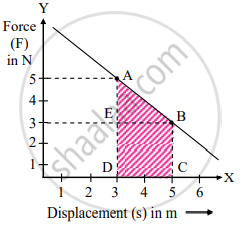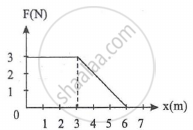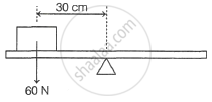Advertisements
Advertisements
Question
Solve the following problem.
While decreasing linearly from 5 N to 3 N, a force displaces an object from 3 m to 5 m. Calculate the work done by this force during this displacement.
Solution 1
For a variable force, work done is given by the area under the curve of force v/s displacement graph. From the given data, the graph can be plotted as follows:

∴ Work done, W = Area of `square`ABCD
∴ W = A(Δ AEB) + A `(square "EBCD")`
`= (1/2 xx "EB" xx "AE") + ("DE" xx "EB")`
`= (1/2 xx 2 xx 2) + (3 xx 2)`
= 8 J
Solution 2
Work done, W = Area of trapezium ADCB
∴ W = `1/2`(AD + CB) × DC
∴ W = `1/2`(5N + 3N) × (5m - 3m)
`= 1/2 xx 8 xx 2` = 8J
APPEARS IN
RELATED QUESTIONS
Answer the following question.
In the following table, every entry on the left column can match with any number of entries on the right side. Pick up all those and write respectively against A, B, C and D.
| Name of the force | Type of the force | ||
| A | Force due to tension in a string | P | EM force |
| B | Normal force | Q | Reaction force |
| C | Frictional force | R | Conservative force |
| D | Resistive force offered by air or water for objects moving through it. | S | Non-conservative force |
Find the odd man out:
Answer the following question.
You are sitting next to your friend on ground. Is there any gravitational force of attraction between you two? If so, why are you not coming together naturally? Is any force other than the gravitational force of the earth coming in the picture?
Solve the following problem.
Power is the rate of doing work or the rate at which energy is supplied to the system. A constant force F is applied to a body of mass m. Power delivered by the force at time t from the start is proportional to ______.
Derive the expression for power in terms of F, m, and t.
Variation of a force in a certain region is given by F = 6x2 – 4x – 8. It displaces an object from x = 1 m to x = 2 m in this region. Calculate the amount of work done.
Solve the following problem.
In the following table, every item on the left side can match with any number of items on the right-hand side. Select all those.
| Types of collision | Illustrations | ||
| a. | Elastic collision | i. | A ball hit by a bat. |
| b. | Inelastic collision | ii. | Molecular collisions responsible for pressure exerted by a gas. |
| c. | Perfectly inelastic collision | iii. | A stationary marble A is hit by marble B and the marble B comes to rest. |
| d. | Head-on collision | iv. | A blob of clay dropped on the ground sticks to the ground. |
| v. | Out of anger, giving a kick to a wall. | ||
| vi. | A striker hits the boundary of a carrom board in a direction perpendicular to the boundary and rebounds. | ||
In air, a charged soap bubble of radius 'R' breaks into 27 small soap bubbles of equal radius 'r '. Then the ratio of mechanical force acting per unit area of big soap bubble to that of a small soap bubble is ______.
Which of the following is the correct order of forces?
A body of mass 'm' begins to move under the action of time-dependent force `vec"F" = ("t"hat"i" + 2"t"^2hat"j")`N where `hat"i" and hat"j"` are unit vectors along x and y axis respectively. The power developed by the force in watt at time 't' is ______.
A force of F = `("x"/2 + 15) "N"` acts on a particle. If x 2 is in metre, calculate the work done by the force during the displacement of the particle from x = 0 to x = 4 m
A force F = (10 + 0.5 x) N acts on a particle in the x-direction. The work done by the force in displacing the particle from x = 0 to x = 2 metre is ______.
Work done in sliding a 1 kg block up a rough inclined plane of height 5 m is 100 J. Work done against the friction is ______.
(g = 10 m/s2)
A Diwali cracker releases 25 gram gas per second, with a speed of 400 ms-1 after explosion. The force exerted by gas on the cracker is ______.
'n' number of balls each having mass 'm' and velocity 'u' hit a wall elastically and normally in 2 seconds. The force exerted by them on the wall is ______.
Out of the fundamental forces in nature, maximum and minimum range is respectively for ______.
A force F acting on an object varies with distance x as shown here. The force is in N and x in m. The work done by the force in moving the object from x = 0 to x = 6 m is ______.

Two rods of same length and transfer a given amount of heat 12 second, when they are joined as shown in figure (i), But when they are joined as shown in figure (ii), then they will transfer same heat in same conditions in ______.


A gardener pushes a lawn roller through a distance of 20 m. If he applies a force of 30 kg-wt in a direction inclined at 60° to the ground, the work done by the gardener in pushing the roller is ______.
`["g" = 9.8 "m""/""s"^2, sin30^circ = cos60^circ = 1/2, cos30^circ = sin60^circ = sqrt3/2]`
Which of the following statements is correct?
A uniform beam is balanced at its mid-point an object placed on the beam as shown.

Which force will rebalance the beam?
